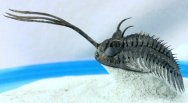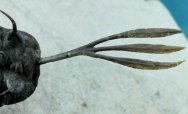Walliserops trifurcatus
The Trident Comura name often also seen
Class Trilobita, Trilobites Order Phacopida, Family Acastidae
Geological Time: Devonian
Size: Trilobite is 90 mm long
Fossil Site: Foum Ziguid, Zagora, Morocco
|
The trident is unprecedented among more than 20,000 trilobite species, an evolutionary enigma, and a functional mystery. Many hypotheses have been put forth regarding why the adaptation took place and the purpose. The appearance of such a prominent phenotypic trait would ostensibly require considerable “evolutionary energy”, for which some substantial selective advantage would be expected for its possessors. Energy would also be expended to grow, and possibly regrow, the protuberance which might have made shedding its exoskeleton more difficult, and it hardly benefitted the trilobites steamlining. Moreover, the trident itself lacks the bilateral symmetry, curving away from the body axis, and distinctive trait among most animals, arthropods and trilobites. Further, there is variability in the trident curvature, with shorter tridents more curved. Several uses of the trident have been discussed: 1) a means of levitating above the seafloor; 2) sophisticated sensory organ; 3) a mechanism for hiding or defending; 4) a mere adornment of sexually (dimorphic) selection as in the staghorn beetle; 5) sexual or caste polymorphism as in social insects. Of course, a combination is plausible, for example, sexually selected armament. As with many other Devonian trilobites, Walliserops sported an impressive array of more than 50 spines as protection in a sea where predator skills and weapons were also evolving. And then, of course, there the trilobite has crystal Schizochroal eyes that were only in trilobites of Order Phacopida, Suborder Phacopina, and which are beautifully preserved in this specimen.
Also see: Moroccan Trilobites; Images provided by Fossil Mall, where you can also see other Walliserops species: Walliserops hammi ; Walliserops n. sp aff. lindoei ; Walliserops n. sp aff. tridens |






